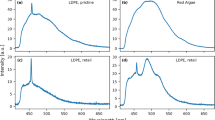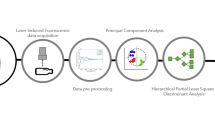Abstract
Automated analysis of microplastics is essential due to the labor-intensive, time-consuming, and error-prone nature of manual methods. Attenuated Total Reflectance Fourier Transform Infrared (ATR-FTIR) spectroscopy offers valuable molecular information about microplastic composition. However, efficient data analysis tools are required to effectively differentiate between various types of microplastics due to the large volume of spectral data generated by ATR-FTIR. In this study, we propose a machine learning (ML) approach utilizing ATR-FTIR spectroscopy data for accurate and efficient classification of undegraded and aged polyethylene terephthalate (PET) microplastics (MPs). We evaluate seven ML algorithms, including Random Forest (RF), Gradient Boosting (GB), Decision Tree (DT), k-Nearest Neighbors (k-NN), Logistic Regression (LR), Support Vector Machine (SVM), and Multi-Layer Perceptron (MLP), to assess their performance. The models were optimized using fivefold cross-validation and evaluated using multiple metrics such as confusion matrix, accuracy, precision, recall (sensitivity), and F1-score. The experimental results demonstrate exceptional performance by RF, GB, DT, and k-NN models, achieving an accuracy of 99% in correctly classifying undegraded and aged PET MPs. The proposed approach capitalizes on the potential of ATR-FTIR spectra to discern distinct chemical signatures of undegraded and aged PET particles, enabling precise and reliable classification. Furthermore, the method offers the benefit of automating the classification process, streamlining the analysis of environmental samples. It also presents the advantage of providing an effective means for method standardization, facilitating more automated and optimized extraction of information from spectral data. The method’s versatility and potential for large-scale application make it a valuable contribution to the field of MP environmental research.


(Adapted from https://scikit-learn.org/stable/modules/cross_validation.html, assessed 28/07/2023)






Similar content being viewed by others
Data Availability
All data associated with this manuscript is presented in the study and its supplementary file.
References
Enyoh CE, Verla AW, Ohiagu FO, Enyoh EC (2021) Progress and future perspectives of microplastic research in Nigeria. Int J Environ Anal Chem. https://doi.org/10.1080/03067319.2021.1887161
Verla AW, Enyoh CE, Verla EN (2019) Microplastics, an emerging concern: a review of analytical techniques for detecting and quantifying microplatics. Anal Methods Environ Chem J. 12:15–32
Chowdhury T, Wang Q, Enyoh CE (2022) Degradation of polyethylene terephthalate microplastics by mineral acids: experimental, molecular modelling and optimization studies. J Polym Environ. https://doi.org/10.1007/s10924-022-02578-z
Enyoh CE, Duru CE, Prosper E, Wang Q (2023) Evaluation of nanoplastics toxicity to the human placenta in systems. J Hazard Mater 446:130600. https://doi.org/10.1016/j.jhazmat.2022.130600
Enyoh CE, Wang Q, Momimul RH, Senlin L (2023) Preliminary characterization and probabilistic risk assessment of microplastics and potentially toxic elements (PTEs) in garri (cassava flake), a common staple food consumed in West Africa. Environ Anal Health Toxicol 38(1):e2023005
Enyoh CE, Wang Q, Senlin L (2023) Optimizing the efficient removal of ciprofloxacin from aqueous solutions by polyethylene terephthalate microplastics using multivariate statistical approach. Chem Eng Sci 278(12):118917
Verla AW, Enyoh CE, Verla EN et al (2019) Microplastic–toxic chemical interaction: a review study on quantified levels, mechanism and implication. SN Appl Sci 1:1400. https://doi.org/10.1007/s42452-019-1352-0
Ioakeimidis C, Fotopoulou KN, Karapanagioti HK, Geraga M, Zeri C, Papathanassiou E, Galgani F, Papatheodorou G (2016) The degradation potential of PET bottles in the marine environment: an ATR-FTIR based approach. Sci Rep. https://doi.org/10.1038/srep23501
Hufnagl B, Steiner D, Renner E, Löder MGJ, Laforsch C, Lohninger H (2019) A methodology for the fast identification and monitoring of microplastics in environmental samples using random decision forest classifiers. Anal Methods 11(17):2277–2285
Kedzierski M, Falcou-Préfol M, Kerros ME, Henry M, Pedrotti ML, Bruzaud S (2019) A machine learning algorithm for high throughput identification of FTIR spectra: application on microplastics collected in the Mediterranean Sea. Chemosphere 234:242–251. https://doi.org/10.1016/j.chemosphere.2019.05.113
Wander L, Vianello A, Vollertsen J, Westad F, Braun U, Paul A (2020) Exploratory analysis of hyperspectral FTIR data obtained from environmental microplastics samples. Anal Methods 12(6):781–791
Da Silva VH, Murphy F, Amigo JM, Stedmon C, Strand J (2020) Classification and quantification of microplastics (<100 μm) using a focal plane array-fourier transform infrared imaging system and machine learning. Anal Chem 92(20):13724–13733. https://doi.org/10.1021/acs.analchem.0c01324
Yan X, Zhi C, Alan M, Yuansong Q (2022) An ensemble machine learning method for microplastics identification with FTIR spectrum. J Environ Chem Eng 10(4):108130. https://doi.org/10.1016/j.jece.2022.108130
Moses SR, Roscher L, Primpke S et al (2023) Comparison of two rapid automated analysis tools for large FTIR microplastic datasets. Anal Bioanal Chem 415:2975–2987. https://doi.org/10.1007/s00216-023-04630-w
Willans M, Szczecinski E, Roocke C, Williams S, Timalsina S, Vongsvivut J, McIlwain J, Naderi G, Linge KL, Hackett MJ (2023) Development of a rapid detection protocol for microplastics using reflectance-FTIR spectroscopic imaging and multivariate classification. Environ Sci: Adv 2(4):663–674
Enyoh CE, Wan Q (2022) Combined experimental and molecular dynamics removal processes of contaminant phenol from simulated wastewater by polyethylene terephthalate microplastics. Environ Technol. https://doi.org/10.1080/09593330.2022.2139636
Enyoh CE, Wang Q, Prosper O (2022) Response surface methodology for modeling the adsorptive uptake of phenol from aqueous solution using adsorbent polyethylene terephthalate microplastics. Chem Eng J Adv. https://doi.org/10.1016/j.ceja.2022.100370
Enyoh CE, Wang Q (2023) Adsorption and toxicity characteristics of ciprofloxacin on differently prepared polyethylene terephthalate microplastics from both experimental and theoretical perspectives. J Water Process Eng 53:103909. https://doi.org/10.1016/j.jwpe.2023.103909
Cinar I, Koklu M (2019) Classification of rice varieties using artificial intelligence methods. Int J Intell Syst Appl Eng 7(3):188–194
Mao W, Wang F (2012) New advances in intelligence and security informatics. Academic Press, Cambridge
Cruyff M, Böckenholt U, van der Heijden PGM, Frank LE, Chaudhuri A, Christofides CT, Rao CR (2016) Handbook of Statistics. Data gathering, analysis and protection of privacy through randomized response techniques: qualitative and quantitative human traits. Elsevier, Amsterdam, pp 287–315
Schölkopf B, Platt JC, Shawe-Taylor J, Smola AJ, Williamson RC (2001) Estimating the support of a high-dimensional distribution. Neural Comput 13(7):1443–1471. https://doi.org/10.1162/089976601750264965
Hastie T, Tibshirani R, Friedman JH (2009) 10. Boosting and additive trees. The elements of statistical learning, 2nd edn. Springer, New York, pp 337–384
Madeh Piryonesi S, El-Diraby TE (2021) Using machine learning to examine impact of type of performance indicator on flexible pavement deterioration modeling. J Infrastruct Syst 27(2):04021005. https://doi.org/10.1061/(ASCE)IS.1943-555X.0000602
Rokach L, Maimon O (2005) Top-down induction of decision trees classifiers-a survey. IEEE Trans Syst, Man, and Cybern—Part C: Appl Rev 35(4):476–487
Wu X, Kumar V, Ross Quinlan J, Ghosh J, Yang Q, Motoda H, McLachlan GJ, Ng A, Liu B, Yu PS, Zhou Z-H (2008) Top 10 algorithms in data mining. Knowl Inf Syst 14(1):1–37. https://doi.org/10.1007/s10115-007-0114-2
Ibeto CN, Enyoh CE, Ofomatah AC, Oguejiofor LA, Okafocha T, Okanya V (2021) Microplastics pollution indices of bottled water from South Eastern Nigeria. Int J Environ Anal Chem. https://doi.org/10.1080/03067319.2021.1982926
Richman JS (2011) Multivariate neighborhood sample entropy: a method for data reduction and prediction of complex data. Methods in enzymology. Elsevier, Amsterdam, pp 397–408
Bikiaris DN, Karayannidis GP (1999) Effect of carboxylic end groups on thermooxidative stability of PET and PBT. Polym Degrad Stab 63(2):213–218. https://doi.org/10.1016/s0141-3910(98)00094-9
Gewert B, Plassmann MM, MacLeod M (2015) Pathways for degradation of plastic polymers floating in the marine environment. Environ Sci Process Impacts 17(9):1513–1521. https://doi.org/10.1039/c5em00207a
Perlich C (2011) Learning curves in machine learning. In: Sammut C, Webb GI (eds) Encyclopedia of machine learning. Springer, Boston
Ying X (2019) An overview of overfitting and its solutions. J Phys: Conf Ser 1168:022022
Acknowledgements
Not applicable.
Funding
This study was partially supported by the Special Funds for Basic Research (B) (No. 22H03747, FY2022-FY2024) of Grant-in-Aid for Scientific Research of Japanese Ministry of Education, Culture, Sports, Science and Technology (MEXT).
Author information
Authors and Affiliations
Contributions
CEE: Conceptualization, Methodology, Software, Formal analysis, Validation, Visualization, Investigation, Data curation, Project administration, Writing–Original draft preparation, Writing—Reviewing and Editing. WQ Supervision, Project administration, Funding acquisition, Resources, Writing- Reviewing and Editing.
Corresponding author
Ethics declarations
Conflict of interest
The authors declare that they have no known competing financial interests or personal relationships that could have appeared to influence the work reported in this paper.
Informed Consent
Not applicable.
Research Involving Human and Animals Participants
Not applicable.
Additional information
Publisher's Note
Springer Nature remains neutral with regard to jurisdictional claims in published maps and institutional affiliations.
Supplementary Information
Below is the link to the electronic supplementary material.
Rights and permissions
Springer Nature or its licensor (e.g. a society or other partner) holds exclusive rights to this article under a publishing agreement with the author(s) or other rightsholder(s); author self-archiving of the accepted manuscript version of this article is solely governed by the terms of such publishing agreement and applicable law.
About this article
Cite this article
Enyoh, C.E., Wang, Q. Automated Classification of Undegraded and Aged Polyethylene Terephthalate Microplastics from ATR-FTIR Spectroscopy using Machine Learning Algorithms. J Polym Environ (2024). https://doi.org/10.1007/s10924-024-03199-4
Accepted:
Published:
DOI: https://doi.org/10.1007/s10924-024-03199-4




